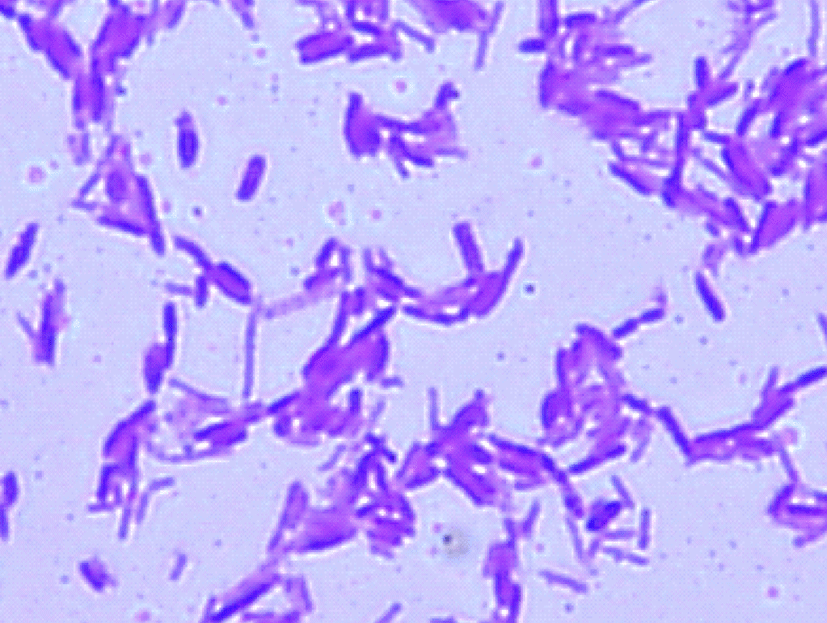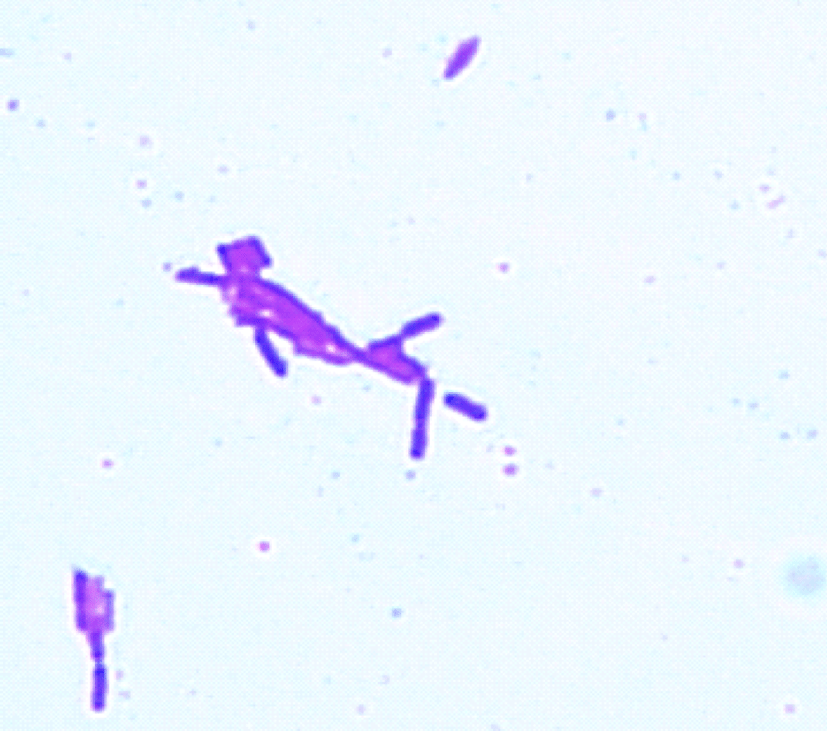서론
식품 제조 공정 중 살균 공정은 가장 중요한 공정 중의 하나로서 식품의 안정성과 저장성을 향상시키기 위하여 보편적으로 사용된다. 살균 공정에 따라 영양소 파괴, 이화학적 및 관능적 특성의 변화 등이 유발되기 때문에 살균 온도와 살균 시간은 많은 예비실험을 통하여 결정된다. 일반적으로 식품 중에 존재하는 부패성 미생물이나 병원성 미생물은 pH를 4 이하로 조정하거나 온도를 85~95℃ 정도까지 상승시킴으로써 이들 세포가 불활성화 된다.
그러나 Splittstoesser 등 (1994)은 pH 3.7 이하에서 85~95℃의 온도로 살균하는 공정에서도 내생포자를 형성하여 사멸하지 않고 식품 안에서 생존할 수 있는 미생물이 존재한다고 보고하였다.
Alicyclobacillus는 토양에 존재하는 세균으로 1984년 살균된 사과 주스의 부패균으로 최초로 보고되었다. Alicyclobacillus로 명명되기 전에는 포자 형성 박테리아의 새로운 형태 종류로 내산성인 Bacillus 종으로 확인되어 Bacillus acidoterrestris라고 명명되었다. 그 후 세포막의 지방산 성분으로 주로 ω-alicyclic 지방산을 가지고 있어 Alicyclobacillus라고 재분류되었다(Deinhard 등, 1987; Wisotzkey 등, 1992; Splittstoesser 등, 1992; Yamazaki 등, 1996).
Alicyclobacillus는 운동성의 포자형성 간균이며 호기성이고 종속영양생물이며, 25~60℃, pH 2.5~ 6.0 범위에서 자라는 특징이 있다. 또한 Alicyclobacillus는 0.6~6.0μm의 다양한 크기이며 20~50℃ 또는 60℃에서 선택배지에 배양을 하면 자라는 고온성균으로 세포의 모양은 Bacilluscirculans의 특징처럼 가느다랗고 길며, 포자는 팽창되어 부풀어진 모양이다(Splittstoesser 등, 1994; Eiroa 등, 1999).
Alicyclobacillus는 90℃에서 D value가 15~16분에서 23분이고, 95℃에서 D value가 2.4~2.8분 정도로 알려져 있는데, 이는 86~96℃에서 2분간 처리하는 hot-filling process의 경우 이 미생물이 사멸하지 않고 생존할 수도 있음을 의미한다(Splittstoesser 등, 1997)
과일 주스나 과일이 첨가된 음료는 제품의 pH가 상대적으로 낮기 때문에 열 처리를 하지 않은 신선한 상태나 고온 처리가 아닌 살균 처리를 한 상태에서 제조된다. 또한 냉장 저장을 하지 않는 과일 주스의 경우에는 유통기한이 길어 저장 중 Alicyclobacillus가 자라게 되어 off-flavor로 인한 제품의 품질에 나쁜 영향을 준다, 이와 같은 결과로 사과, 복숭아, 포도 및 배 주스 등을 생산하는 공장에 많은 피해를 끼친다.
따라서 본 연구에서는 과일 주스의 부패균으로 알려진 Alicyclobacillus를 시판 중인 과일 주스에서 분리하여, 열처리에 대한 저항성을 평가하고자 수행하였다.
재료 및 방법
본 실험에 사용된 Alicyclobacillus를 과일 주스에서 분리하기 위하여 과일 주스 100 mL를 Whatman 0.45 μM sterile membrane filter를 이용하여 여과한 다음 filter에 남은 과일 주스의 잔여물을 filter와 함께 각각 potato-dextrose agar에 10% Tartaric acid를 넣어 pH 3.7로 제조한 배지에 중층하여 45℃에서 약 5일간 배양하여 집락을 선별하였다. 증균용 배지로는 Yeast Extract 0.25 %, Peptone 0.5 %, Glucose 0.1%, Tween80 0.1%, Agar 1.5%를 첨가하여 제조한 배지에 10% CaCl2 0.5%를 넣고 멸균된 10% Tartaric acid를 넣어 pH 4.0으로 조정하여 사용하였다.
결과 및 고찰
본 실험에 사용된 균은 전남대학교 동물자원학부 미생물공학 실험실에서 과일 주스에서 분리 보관중인 미생물 3종에 대하여 Gram 염색, KOH test, 포자 형성 유무 등을 확인하였으며, 이들 미생물을 동정한 결과 전부 Alicyclobacillus로 동정되었다.
Fig. 1은 Alicyclobacillus JNU1 균주에 대하여 70℃, 80℃ 및 90℃에서 열저항성을 평가한 결과를 나타낸 것이다. 열처리 후 약 4~5 log CFU 감소를 보였으며, 열처리 시간이 1~2분 이후부터는 더 이상 사멸하지 않고 일정하게 유지되는 것으로 나타났다. Alicyclobacillus JNU1 균주는 열처리 온도에서 일정한 시간이 지나면 포자를 형성하는 것으로 판단되며, 전형적인 Alicyclobacillus의 특징을 나타내고 있는 것으로 확인되었다. Alicyclobacillus JNU2 균주는 Alicyclobacillus JNU1 균주보다 열저항이 높은 것으로 나타났는데, 80℃ 열처리에서 5분까지 약 1 log CFU 정도만 감소하였다(Fig. 2).
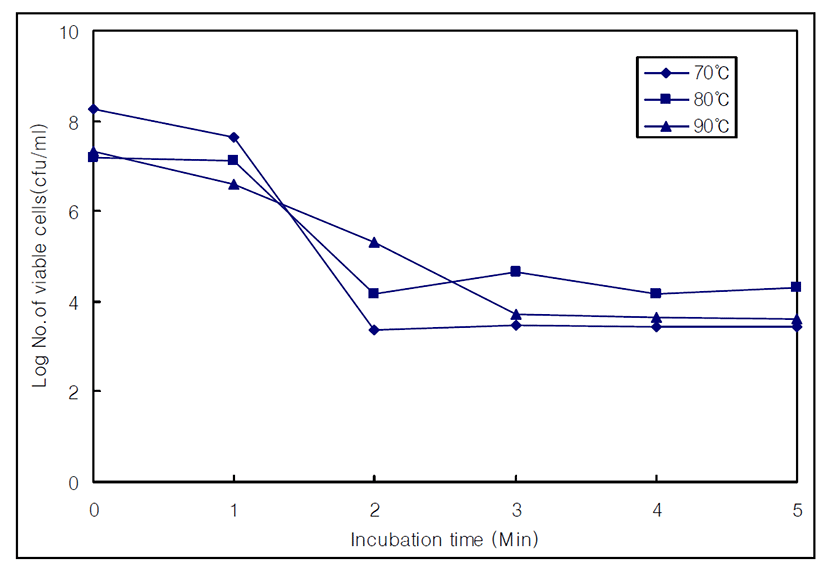
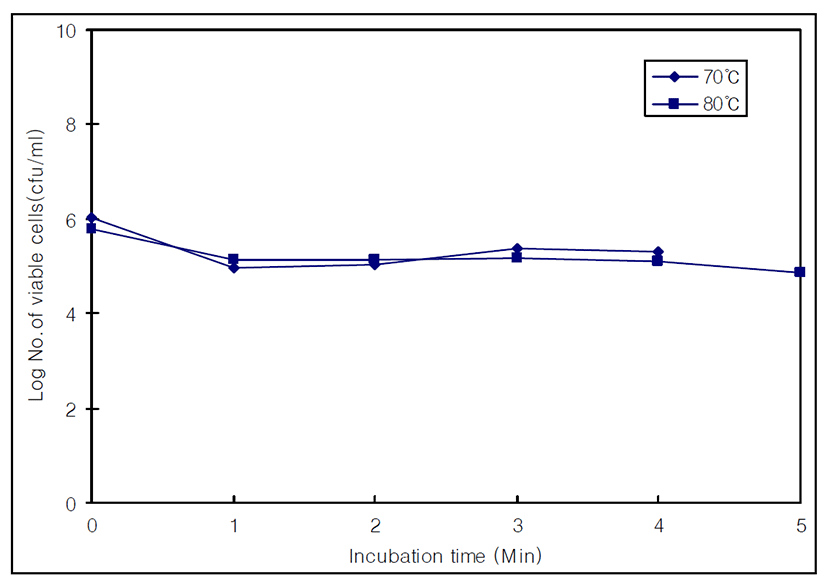
Fig. 3은 Alicyclobacillus JNU3 균주에 대한 열저항성을 평가한 것으로 열처리 1분까지는 저항성이 높게 나타났지만, 2분 이상의 열처리시에는 급격하게 사멸하는 것으로 나타났다. Alicyclobacillus JNU3는 0~2분 사이에 사멸하는 속도가 빨랐으나, 3~4분 사이에 조금 더 완만하게 그 속도가 감소하였고, 열처리 4분 이후에는 Alicyclobacillus JNU1과 같이 포자를 형성하여 그 이상의 사멸이 나타나지 않고 일정한 수준을 유지하였다.
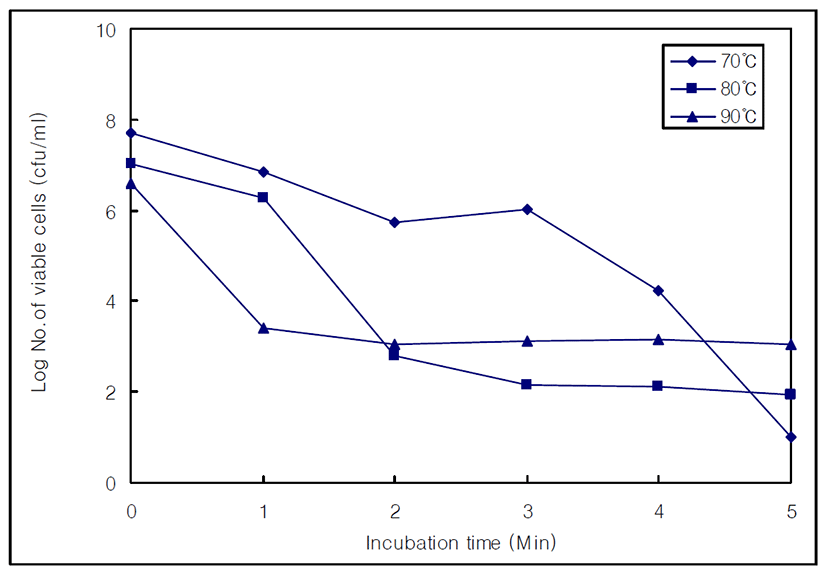
Pontius 등(1998)과 Eiroa 등(1999)은 Alicyclobacillus의 세포가 과일 주스에 존재하는 다른 미생물 즉, 유산균이나 효모보다 더 강한 열처리가 요구된다고 하였는데, 그 이유는 이들보다 높은 열 저항성 포자를 형성하기 때문이라고 보고하였다.
Table 1은 Alicyclobacillus 3균주에 대하여 70℃, 80℃ 및 90℃에서 열 저항성을 측정하고, 그에 따른 회귀식을 구한 다음에 D value를 계산한 것이다. Alicyclobacillus JNU1은 70℃에서 D value가 1.9분, 80℃는 2.1분, 90℃에서 1.9분으로 각각 계산되었고, Alicyclobacillus JNU2는 70℃에서 D value가 4.7분, 80℃는 6.5분으로 조사되었다. Alicyclobacillus JNU3의 D value는 70℃에서 2.3분, 80℃는 1.4분, 90℃에서 0.1분으로 각각 계산되었다. Komitopoulou 등(1999)은 pH가 3.51인 사과 주스에서 A. acidoterrestris의 D value는 90℃에서 7.4분, 5℃에서는 2.3분이라고 보고하였다.
| Strain | T(℃) | Dvalue |
|---|---|---|
| JNU1 | 70 | 1.3 |
| 80 | 2.1 | |
| 90 | 1.9 | |
| JNU2 | 70 | 4.7 |
| 80 | 6.5 | |
| JNU3 | 70 | 2.3 |
| 80 | 1.4 | |
| 90 | 0.1 |
또한 Splittstoesser 등(1994)의 연구보고에 의하면 pH 3.50인 사과 주스에서의 A. acidoterrestris의 D value가 90℃에서 23분, 95℃에서 2.8분이었다고 보고하였다.
Table 2와 Fig. 4는 Alicyclobacillus 3균주에 대한 형태학적 특징을 조사한 것이다. 실험 결과, 다른 내열성 bacilli와 유사한 특성을 지닌 것으로 확인되었으며, 이들 균주에 대한 정확한 동정은 추후 16s rDNA 분석을 통하여 밝혀져야 할 것이다.
| Strains | KOH test | Gram staining | Spore |
|---|---|---|---|
| JNU1 | - | + | + |
| JNU2 | - | + | + |
| JNU3 | - | + | + |








